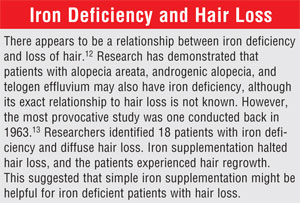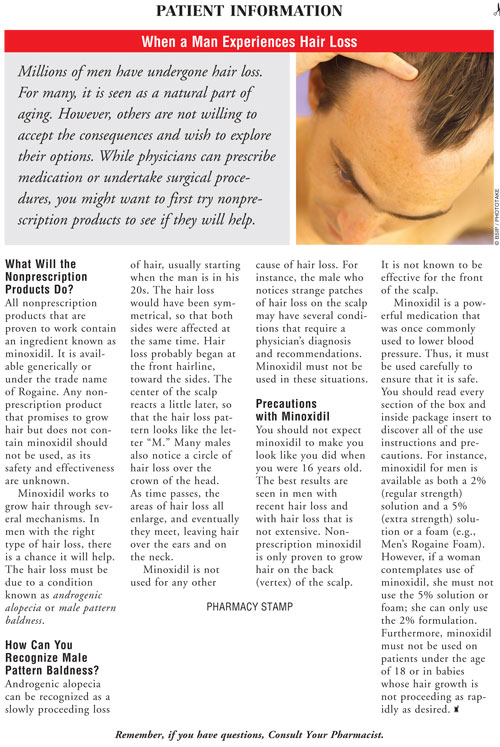US Pharm.
2008;33(8):16-20.
Human hair carries many
connotations. A full head of hair is characteristic of youthful males, so
those favored with an abundance of hair are assumed to have the qualities of
that group, such as energy, athletic prowess, and being at the peak of one's
sexual potential.1 By contrast, hair loss is usually considered to
be characteristic of older males, and it carries such unwarranted implications
as lack of vigor, sexual impotence, general loss of capable functioning, and
medical illnesses. Males suffering from appreciable hair loss report feelings
of lowered self-worth, loss of confidence, and a feeling of being older than a
set of age-matched counterparts without hair loss.2
Phases of Hair Growth
The healthy human
head contains an average of 100,000 hairs in different stages of the
follicular life cycle.3 As many as 85% are in anagen, a
long-lasting (2-7 year) metabolically active growth phase. Following anagen, a
hair enters a short phase known as catagen for one to three weeks,
during which the follicle shrinks and the lower section of hair is destroyed.
This is followed by a final five- to six-week phase known as telogen,
during which the hair is usually lost. At the end of this phase, a new hair
begins to grow in the follicle.
Causes of Hair Loss
There are many
reasons for hair loss. They are often subdivided into scarring (cicatricial)
or nonscarring alopecias.3 Generally, alopecias that scar the scalp
produce permanent damage. By contrast, hair can usually regrow when alopecias
are a result of nonscarring processes. There are exceptions to this general
rule, but it serves as a useful guide in many situations.
Permanent hair loss due to
scarring alopecias can result from chronic cutaneous lupus erythematosus,
lichen planopilaris, classic pseudo pelade of Brocq, central centrifugal
cicatricial alopecia, alopecia mucinosa, keratosis follicularis spinulosa
decalvans, and other disorders.3,4 None of these can be
self-treated.
Temporary hair loss due to
nonscarring alopecias may be caused by several problems, including androgenic
alopecia, acute or chronic telogen effluvium, alopecia areata, traction
alopecia, and trichotillomania.3 While alopecias due to these
diagnoses are usually considered temporary, in their latter stages they may
become permanent, as seen in long-term androgenic alopecia, alopecia areata,
and traction alopecia.3
Hair loss can also indicate
the presence of a sexually transmitted disease. Syphilis cases are increasing,
and the secondary form of the condition can cause a moth-eaten appearance,
with patches of loss, a generalized loss, or both.5 HIV also
commonly causes hair loss. The most frequent feature of HIV-associated loss is
straightening of the hair, but the texture may also change to a finer
consistency and the hair may break more readily.5
Manifestations of
Androgenic Alopecia
It is critical for
the pharmacist to be able to recognize androgenic alopecia and to refer
patients suffering from any other type of hair loss to a dermatologist or
other physician for appropriate diagnosis and treatment.
Androgenic alopecia can be
recognized in most cases by its appearance. Classic androgenic alopecia is
also known as male pattern baldness, a gradual thinning of the hair
that moves symmetrically from the frontal and parietal areas.6,7
The central vertex is usually the last to be affected, leading to the classic
"M" of male pattern baldness. Patients often also lose hair at the crown of
the head. However, over time the vertex hair thins out appreciably and the
balding spot at the crown merges with the central vertex, leaving hair only
around the ears and neck. Even this hair is thinner, with a slowing of its
growth.
Patients approach the
pharmacist for assistance at all stages of this scenario. Unfortunately,
nonprescription products work best at the earliest stages, and often fail
completely when the patient has already experienced advanced androgenic
alopecia.
Prevalence of Androgenic
Alopecia
Androgenic alopecia
is the most common cause of hair loss in males.6 The overall
incidence in Caucasian men may be as high as 96% or more, but the exact
prevalence is unknown.2 Estimates should include the ages for which
the estimate has been generated and the degree of hair loss. Caucasian men
aged 20 to 40 years have bitemporal recession in 62% of cases. In men aged 18
to 49 years, the incidence of hair loss measured as type III or greater on the
well-accepted Hamilton-Norwood hair loss rating scale is estimated to be at
least 42%. Within the ages 40 to 49 years, however, 53% are estimated to have
moderate-to-extensive hair loss.2
Etiology of Androgenic
Alopecia
The proposed dual
etiologies of androgenic alopecia are found in its name. In order for the
condition to manifest, it was thought for years that the patient must be
genetically predisposed. In this theory, it was thought that the condition
only manifests in these patients under androgenic stimulation. A recent trend
is emerging where androgenic stimulation is thought to produce hair loss
independent of the patient's genetic predisposition.6
The prepubertal male's body is
virtually covered with tiny vellus hairs (except for glabrous skin such as the
lips, palms, and soles).1 The hairs are fine and not noticeable in
most areas. At puberty, the male experiences a surge of androgens, such as
testosterone. Testosterone undergoes intracellular metabolism through the
influence of 5-alpha reductase to become 5-alpha-dihydrotestosterone, which is
of greater potency than the parent compound.1 Under its influence,
the male's body develops long terminal hairs that are deeply pigmented. The
normally developing male notices these changes on the legs, arms, underarms,
chest, back, pubic area, and face. However, in the genetically predisposed
individual, 5-alpha-dihydrotestosterone exerts a paradoxical effect on the
scalp. In specific regions of the scalp, it causes follicles to undergo a
reverse reaction. Rather than moving from vellus to terminal hair, terminal
hairs revert to tiny vellus-like hairs that are difficult to see.
Treatment of Hair Loss
The only
FDA-approved treatments for hair loss are the prescription product finasteride
(Propecia) and nonprescription minoxidil (Rogaine).8
Nonprescription minoxidil is only indicated for androgenic alopecia. The
packaging includes illustrations to clearly instruct the potential user on the
typical look of the condition, advises use only on the crown of the scalp, and
cautions against use if the amount of hair loss is different from that shown
on the package or is on the frontal scalp (i.e., receding hairline).9-11

Instructions for Use of
Minoxidil
All minoxidil
products are flammable and must not be used around fire or flame.9-11
The products instruct against use when hair loss is sudden and/or patchy, if
the patient has no family history of hair loss, does not know the reason for
hair loss, is less than 18 years of age, has a scalp that is abnormal (red,
inflamed, infected, or painful), or uses other medications on the scalp.
Patients are cautioned not to apply the product to any other area of the body
and to avoid contact with the eyes. They should ask a physician before use if
they have heart disease. They should stop use and speak to a physician if they
experience chest pain, tachycardia, faintness, or dizziness, if they have
sudden unexplained weight gain, if the hands or feet swell, if the scalp
becomes red or irritated, if they notice unwanted growth of facial hair, or if
there is not hair regrowth in four months.
The pharmacist should stress
to potential minoxidil users that the product is useless if it remains on the
hair, and that it must contact the scalp itself to begin to exert any activity.8
Patients are directed to apply 1 mL of the product using the enclosed dropper
(or one-half capful if using the foam product) twice daily, directly onto the
crown in the area where hair has been lost.9-11 They should use the
fingers to massage the solution or foam into the scalp and wash the hands
after doing so. They must understand that it will not be effective in all
patients, and that hair color and/or texture may change. Increasing the dose
beyond that advised on the label to help the product's efficacy is dangerous.
To be fully effective, the product should remain on the scalp for a full four
hours, giving time for maximum absorption.8 Thus, patients should
not go to bed (where the product can be rubbed off on the pillows), wear a cap
or hat, take a shower or bath, walk in the rain, or engage in any other
activity that would wash or remove it from the scalp before it dries.
Realistic Expectations
Patients should be
advised that the product acts slowly, if at all. With the 2% solution,
twice-daily usage for four months may be necessary before results are
noticeable. For the 5% solution and foam, patients may see results in two
months, but they may also need four months.
The manufacturer states that
in trials that enrolled mostly Caucasian males aged 18 to 49 years with only
moderate hair loss, after four months using the 2% solution, 26% reported
moderate to dense regrowth (as compared to 11% using placebo), and 33% had
minimal regrowth (as compared to 31% using placebo).10 Thus, in
those trials, it appears that 41% of users experienced no growth, as opposed
to 58% of those using placebo. In those same trials, the 5% solutions provoked
greater response than the 2% product.9-11 However, the manufacturer
also states that hair regrowth has not been proven to last beyond four years
with continuous 5% treatment.9
Patients should also be
informed that if minoxidil does provide noticeable increase in hair, it is
necessary to continue to use the product for as long as the male wishes to
keep the regrown hair. If the product is discontinued, the hair will no longer
be stimulated to grow, and it will begin to slowly and gradually diminish.8
The hair loss will not be sudden or immediate, but the scalp will eventually
return to its former state, usually within six months.8
If the patient has used
minoxidil for any appreciable length of time, he may notice that the hair loss
area is larger upon cessation of minoxidil than when he began. This is due to
the fact the progress of androgenic alopecia is not suspended while minoxidil
is being used. It may appear to be slowed or halted, but this is solely due to
minoxidil's influence. Enlargement of the area of vertex baldness can mislead
the male into blaming minoxidil, but the pharmacist can explain that the
male's androgenic alopecia has simply progressed beyond where it was when the
product use was initiated.

REFERENCES
1. Randall VA.
Hormonal regulation of hair follicles exhibits a biological paradox. Semin
Cell Dev Biol. 2007;18:274-285.
2. Otberg N, Finner AM,
Shapiro J. Androgenetic alopecia. Endocrinol Metab Clin North Am.
2007;36:379-398.
3. Sellheyer K,
Bergfeld WF. Histopathologic evaluation of alopecias. Am J Dermatopathol.
2006;28:236-259.
4. Otberg N, Wu WY,
McElwee KJ, Shapiro J. Diagnosis and management of primary cicatricial
alopecia: part 1. Skinmed. 2008;7:19-26.
5. Vafaie J, Weinberg
JM, Smith B, Mizuguchi RS. Alopecia in association with sexually transmitted
disease: a review. Cutis. 2005;76:361-366.
6. Bienova M, Kucerova
R, Fiuraskova M, et al. Androgenetic alopecia and current methods of
treatment. Acta Detmatovenerol Alp Panonica Adriat. 2005;14:5-8.
7. Dao H Jr, Kazin RA.
Gender differences in skin: a review of the literature. Gend Med.
2007;4:308-328.
8. Ross EK, Shapiro J.
Management of hair loss. Dermatol Clin. 2005;23:227-243.
9. Men's Rogaine Extra
Strength Topical Solution. McNeil-PPC, Inc.
http://rogaine.com/Mens/DrugFacts.aspx?ID=1942&CID=433. Accessed June 20, 2008.
10. Men's Rogaine
Regular Strength Topical Solution. McNeil-PPC, Inc.
http://rogaine.com/Mens/DrugFacts.aspx?ID=1944&CID=432. Accessed June 20, 2008.
11. Men's Rogaine Foam.
McNeil-PPC, Inc. http://rogaine.com/Mens/DrugFacts.aspx?ID=1938&CID=1072.
Accessed June 20, 2008.
12. Trost LB, Bergfeld
WF, Calogeras E. The diagnosis and treatment of iron deficiency and its
potential relationship to hair loss. J Am Acad Dermatol.
2006;54:824-844.
13. Hard S. Non-anaemic
iron deficiency as an etiologic factor in diffuse loss of hair of the scalp in
women. Acta Derm Venereol. 1963;43:562-569.
To comment on this article, contact rdavidson@jobson.com.





